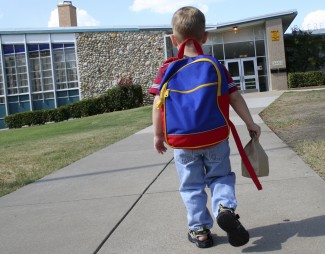If each K-12 student in the United States were to bring a check for more than $3,000 to their school and ask for a healthier school environment in return, how should the school spend that money? That is the multibillion-dollar question all schools are facing during their budget planning this summer as they prepare to receive a vast infusion of federal relief funds.
This funding, totaling $190.5 billion via the Elementary and Secondary School Emergency Relief (ESSER) fund, gives schools an unprecedented opportunity to make vital improvements. They can benefit by improving ventilation as part of a broader retrofit that includes more efficient heating and cooling. This win-win strategy can reduce the risk of virus transmission and exposure to environmental health hazards and, at the same time, reduce energy waste and utility bills.
Schools need to act swiftly—and wisely. Cranking up ventilation without a holistic HVAC (heating, ventilation, and air conditioning) approach could increase energy use and climate-warming emissions. The federal relief funds can plant seeds for change, but schools need more support to upgrade effectively and address competing priorities. We need to think creatively to leverage additional resources—as outlined in this post—to help schools achieve multiple goals at once.
Schools face serious challenges
Although the United States spends heavily on education, significant funding gaps still exist, particularly in most minority and low-income school districts. According to a study by the Century Foundation, the total funding gap is $150 billion, and low-income school districts are more than twice as likely to have a funding gap as higher-income districts.
Many schools also have aging and inadequate facilities. An estimated 41% of public school districts need to update or replace HVAC systems in at least half of their schools, representing approximately 36,000 schools nationwide, according to a 2020 Government Accounting Office (GAO) report. Another field study, published by science journal Indoor Air, revealed that 87% of the sampled classrooms had ventilation rates below levels recommended by the American Society of Heating, Refrigerating and Air-Conditioning Engineers (ASHRAE). It also found that these ventilation rates are correlated with students’ academic achievement.
Schools need to combat several chronic respiratory or communicable diseases, not just the coronavirus causing COVID-19. About 7% of children have asthma, and the number has been increasing every year, especially among Black children. And let’s not forget influenza viruses and rhinovirus, the predominant cause of the common cold. As schools make classroom sanitization their top priority, cleaning products that contain volatile organic compounds can cause adverse health effects, such as asthma attacks, upper respiratory irritation, and fatigue. In addition to hygiene and sanitation practices, effective ventilation is a key measure to ensure a healthy indoor environment in schools.
Federal relief funds present an unprecedented opportunity
The federal relief funds aim to help schools address the many impacts of COVID-19 on education. Schools can use the funds to hire additional teachers, pay for extended learning and enrichment programs, and buy technological devices to assist remote learning. They can also use the money to improve ventilation, not only to reopen quickly and safely, but also to pay for an enormous backlog of projects that address deferred maintenance and overdue capital improvements.
While the federal ESSER funding amounts to an average of $3,378 per student nationwide ($190.5 billion divided by 56.4 million K-12 enrollments in 2020), it will be distributed to states based on their share of Title I funding. In other words, states with a higher share of low-income students will get relatively more funding.
Unfortunately, there are few comprehensive statewide assessments to determine school facilities' needs and this task is left to school districts. Many schools have competing priorities, especially those in disadvantaged communities. Indoor air quality and energy efficiency are not likely the top priorities for school boards or principals. On average, schools spent slightly more than 8% of their budget on operation and maintenance in the past two decades.
Improving ventilation is a complicated task. Many schools cannot implement the recommended strategies for improving indoor air quality to minimize the risk of coronavirus or other indoor virus transmissions because of outdated HVAC systems, according to a joint report by the U.S. Green Building Council (USGBC) and ASHRAE.
Without a comprehensive facility assessment and upgrade planning, adding high-efficiency filters or increasing outdoor air supply is like putting a band-aid on a broken leg. After a class-action lawsuit alleged that a company misrepresented how well its air cleaning devices protect against the spread of the coronavirus, a Newark, California, school district had to disconnect more than 550 classroom air treatment devices costing nearly $360,000.
Energy community should help schools achieve goals
Modernizing aging school facilities is a long-term effort that requires significant investments from the public and private sectors. We recommend that federal agencies, local governments, utilities, nonprofit organizations, and other stakeholders collectively take the following steps to mobilize resources and provide technical and financial support.
— Conduct statewide facilities’ assessment to identify and prioritize needs. The GAO report revealed that most states do not conduct statewide assessments to determine school facilities’ needs. Local education agencies, which will receive at least 90% of the ESSER funding, need help from energy experts to develop quick and feasible ways to assess schools’ efficiency and indoor air conditions.
— Broaden communication with school districts and align efficiency with health and academic goals. Although the Better Buildings Initiative at the Department of Energy (DOE) has engaged 40 school districts as partners, that is less than 3% of the 13,800 public school districts in the United States. We need to broaden stakeholder groups and create more effective communication with educators—helping local education agencies, school boards, and other stakeholders understand the synergy among energy efficiency, carbon reduction, indoor air quality, and student academic performance.
Numerous studies have proven that a healthy indoor environment has a direct positive impact on students’ physical and mental health and their academic performance. Illness results in 184 million missed school days each year nationwide, hurting academic performance and possibly widening income-based achievement gaps. For example, absenteeism has a more substantial impact on the performance of Hispanic English language learners. Efficient building systems not only reduce carbon emissions but also provide a more comfortable and healthier indoor environment at a lower operation and maintenance cost.
— Support schools to develop customized strategies at scale. Based on experiences and challenges from 47 school districts, the USGBC/ASHRAE report noted that these districts want a customized plan to address their unique circumstances. Schools could start by monitoring indoor air quality and use the data to develop performance-based ventilation practices. Many schools may not know that they have indoor air quality problems. Indoor air sensors are fairly affordable and easy to use. Local universities and nonprofit organizations could lend their expertise and volunteer technical support.
The Environmental Protection Agency’s (EPA) Health Learning Environments and DOE’s Better Buildings for schools have provided technical resources to build healthy, efficient schools. The Consolidated Appropriations Act of 2021 directs DOE to review existing programs and initiatives across the federal government and to give states and local education agencies technical assistance for boosting energy efficiency. DOE is developing an Efficient and Healthy Schools Campaign to advise schools on how to improve ventilation as part of broader retrofits that save energy and improve indoor air quality.
— Create and leverage other funding sources on efficiency and resilience. The $190.5 billion federal relief funds consist of $13.5 billion from the Coronavirus Aid, Relief and Economic Security (CARES) Act, $54.3 billion from the Coronavirus Response and Relief Supplemental Appropriations Act, 2021 (CRRSA), and $122.7 billion from the American Rescue Plan Act. While schools can use these funds to upgrade HVAC systems that improve ventilation, many schools will likely spend them on other priorities, such as hiring teachers.
In an interview with The New York Times, Dr. Perrigan, the superintendent of a rural Virginia school district and the president of a school coalition, emphasized that improving school facilities would have a lasting impact on their communities for generations to come. Unfortunately, the schools are deterred from using the funds as a down payment on long-term capital improvements, because the funds must be spent by 2025.
More federal funding dedicated to improving school efficiency and resilience is needed. Senator Ed Markey, D-Mass., and Rep. Jamaal Bowman, D-N.Y., recently introduced the Resilient Schools Act of 2021 to provide $40 billion to promote climate resilience, with energy efficiency as a critical component. Rep. Bowman, a former school principal, also proposed the Green New Deal for Public Schools Act that would, among other things, retrofit every public school building to remove asbestos, increase energy efficiency, and install renewable energy on-site or procure clean energy.
Utilities and other local sources should leverage their funding to bolster the federal programs. For example, the Tennessee Valley Authority has launched a School Uplift program to invest $7.3 million over the next three years to help 160 public schools in seven states upgrade aging facilities.
Public–private partnership is essential to transform K-12 public schools in the next decade. Even though the COVID-19 pandemic has started to recede in some parts of the U.S., we need an all-hands-on-deck approach to develop a short-term plan that helps schools reopen quickly and safely and supports long-term goals that modernize school facilities and provide every American child with a healthy, efficient, and resilient learning environment.



